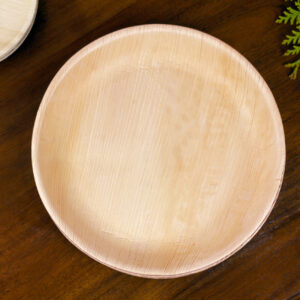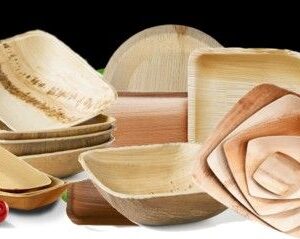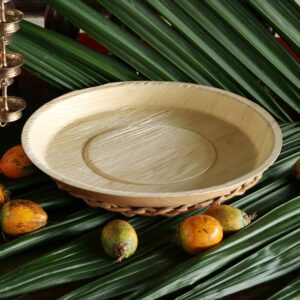In today’s world, where sustainability and eco-friendliness are gaining paramount importance, the utilization of palm leaf party plates stands as a remarkable solution. These plates, crafted from fallen palm leaves, not only serve as a functional alternative to conventional disposable tableware but also contribute significantly to environmental preservation.
The Making of Palm Leaf Plates
The process of crafting palm leaf plates is a testament to sustainable ingenuity. It commences with the collection of naturally fallen palm leaves from trees, ensuring no harm to the living flora. These leaves are gathered in a manner that promotes the health and growth of the trees, maintaining the ecological balance of the environment.
Once collected, the leaves undergo a thorough cleaning process to remove any impurities while preserving their natural texture and color. This cleaning phase is crucial in ensuring the plates remain hygienic and safe for use.
The next step involves the skilled artisans who masterfully shape the cleaned leaves. Through a combination of heat and pressure, the leaves are pressed into molds, forming the desired plate shapes and sizes. This technique doesn’t involve the use of any chemicals or additives, maintaining the plates’ organic and non-toxic nature.
After the shaping process, the plates are left to dry naturally under the sun, allowing them to gain strength and durability. This natural drying method ensures that the plates retain their robustness without relying on artificial means.
The final stage involves a quality check where each plate is inspected for consistency in shape, sturdiness, and overall quality. This meticulous examination guarantees that only premium-grade palm leaf plates reach the market, meeting both quality and eco-friendly standards.
In essence, the making of palm leaf plates epitomizes a harmonious blend of nature’s offerings and human craftsmanship, resulting in eco-friendly, durable, and aesthetically pleasing dinnerware.
Advantages of Palm Leaf Plates
Durability and Sturdiness
Palm leaf plates boast exceptional durability despite their organic origin. Their innate strength makes them suitable for serving various types of cuisine, from light snacks to heavier meals, without compromising on stability.
Aesthetics and Versatility
These plates exhibit a natural, earthy charm with their intricate patterns and textures. Their aesthetic appeal enhances the presentation of food, making them an elegant choice for any occasion, whether it’s a casual gathering or a formal event. Additionally, their versatile nature allows for use in diverse settings, adding a touch of eco-friendly sophistication.
Chemical-Free Nature
One of the standout advantages of palm leaf plates is their chemical-free composition. They are free from toxic coatings or chemicals, ensuring that the food served on them remains uncontaminated and safe for consumption. This natural quality aligns perfectly with the growing demand for non-toxic, eco-conscious dining options.
Environmental Friendliness
Palm leaf plates are crafted from naturally shed leaves, eliminating the need for deforestation or harming living trees. Their production process involves no synthetic materials or chemicals, contributing significantly to reducing the carbon footprint. Furthermore, their biodegradable nature ensures they decompose quickly after disposal, minimizing environmental impact.
Strength and Reliability
Despite their organic origin, palm leaf plates exhibit remarkable strength and resilience. They can withstand a range of temperatures, making them suitable for both hot and cold food items. This durability ensures that they don’t wilt or lose their structure when used with moist or oily foods, making them a reliable choice for various culinary needs.
In essence, the advantages of palm leaf plates extend beyond their eco-friendly composition. Their durability, aesthetics, and chemical-free nature make them a preferred choice for those seeking sustainable and elegant dining solutions.
Comparative Analysis with Other Disposable Plates
Palm Leaf Plates vs. Paper Plates
Durability:
- Palm Leaf Plates: Known for their exceptional durability, palm leaf plates can withstand heavier foods without losing their structural integrity.
- Paper Plates: While convenient, paper plates are prone to becoming soggy and flimsy when in contact with moist or oily foods, compromising their durability.
Eco-Friendliness:
- Palm Leaf Plates: Crafted from naturally fallen palm leaves, palm leaf plates are entirely biodegradable, causing minimal environmental impact after disposal.
- Paper Plates: Despite being disposable, most paper plates are coated with plastic or wax to prevent leakage, making them less eco-friendly and harder to decompose.
Heat Resistance:
- Palm Leaf Plates: Resilient to both hot and cold temperatures, palm leaf plates retain their shape and sturdiness without warping or softening.
- Paper Plates: Often struggle with retaining their structure when exposed to hot foods or liquids, leading to potential spills or leaks.
Palm Leaf Plates vs. Plastic Plates
Environmental Impact:
- Palm Leaf Plates: Made from natural and biodegradable materials, palm leaf plates have a minimal environmental footprint and decompose quickly after disposal.
- Plastic Plates: Not biodegradable, plastic plates contribute significantly to pollution and can take hundreds of years to break down, posing a severe threat to ecosystems.
Chemical Composition:
- Palm Leaf Plates: Chemical-free and derived solely from palm leaves, these plates are safe for serving food, maintaining the purity of the meals.
- Plastic Plates: Often manufactured using various chemicals, some of which may leach into food, potentially posing health risks.
Sturdiness:
- Palm Leaf Plates: Known for their sturdy build, palm leaf plates can handle a wide range of foods without bending or breaking easily.
- Plastic Plates: While durable, plastic plates can be prone to cracking or breaking under pressure, especially with hot foods.
In summary, palm leaf plates surpass paper and plastic plates in terms of durability, eco-friendliness, and safety for both serving and the environment. Their natural composition, heat resistance, and sturdiness make them a superior choice for those seeking sustainable and reliable disposable dinnerware.
Use Cases and Versatility
Events and Parties
Outdoor Gatherings:
- Picnics: Ideal for picnics and outdoor events due to their sturdy nature and ability to withstand various weather conditions.
- Barbecues: Perfect for serving grilled foods, as they maintain their shape and structure even with hot or oily dishes.
Celebrations:
- Weddings: Aesthetic and eco-friendly, palm leaf plates add a touch of elegance to wedding receptions while aligning with sustainability themes.
- Birthday Parties: Versatile enough to serve snacks, cakes, or full meals, enhancing the presentation with their natural appeal.
Restaurants and Catering Services
Fine Dining:
- Fine Dining Restaurants: Used as stylish dinnerware, offering a sophisticated touch while reflecting the restaurant’s commitment to eco-conscious practices.
- Catering Events: Preferred by catering services for their elegance and versatility, fitting seamlessly into diverse event themes.
Daily Household Use
Family Meals:
- Regular Meals: Suitable for everyday use, whether it’s breakfast, lunch, or dinner, offering a sustainable alternative to regular dinnerware.
- Special Occasions: Versatile enough to elevate family gatherings or small celebrations at home, adding an eco-friendly charm to the table setting.
Food Trucks and Food Stalls
Street Food:
- Food Trucks: Used by food trucks and stalls to serve street food, showcasing both the food’s appeal and the commitment to sustainable packaging.
- Food Festivals: Well-suited for food festivals and markets, providing an eco-friendly serving option for various cuisines.
The Role of Palm Leaf Plates in Environmental Conservation
Natural Decomposition:
- Biodegradable Nature: Palm leaf plates are crafted from fallen palm leaves, making them entirely biodegradable. After disposal, they naturally decompose within weeks, unlike plastic or styrofoam alternatives that can take centuries to break down.
- Reduced Waste Accumulation: By decomposing quickly, these plates minimize waste accumulation in landfills, alleviating the strain on the environment and ecosystems.
Preservation of Trees and Forest Ecosystems
Sustainable Sourcing:
- No Trees Cut Down: Palm leaf plates are made from naturally fallen leaves, eliminating the need to cut down trees for their production. This sustainable sourcing method preserves the trees and forest ecosystems, maintaining biodiversity and ecological balance.
- Minimal Environmental Impact: Harvesting naturally shed leaves does not disrupt the natural habitat or cause deforestation, contributing to the conservation of natural resources.
Reduced Carbon Footprint and Eco-Friendly Production
Low Carbon Emissions:
- Environmentally Friendly Process: The production process of palm leaf plates involves minimal energy consumption and does not emit harmful gases or chemicals, reducing the carbon footprint compared to conventional plate manufacturing methods.
- Chemical-Free Production: The plates are manufactured without the use of chemicals or synthetic materials, ensuring they are safe for both the environment and human health.
Promotion of Sustainable Consumer Choices
Advocacy for Eco-Conscious Living:
- Consumer Awareness: Palm leaf plates encourage consumers to make sustainable choices by opting for eco-friendly alternatives. They serve as a tangible example of sustainable living practices, prompting individuals and businesses to consider the environmental impact of their choices.
- Supporting Sustainable Practices: By choosing palm leaf plates, individuals and businesses actively support sustainable practices, contributing to a larger movement towards a greener, more environmentally conscious society.
In essence, palm leaf plates play a significant role in environmental conservation by offering a sustainable, biodegradable alternative to conventional disposable dinnerware. Their production, from sourcing to disposal, aligns with principles of eco-friendliness, reducing waste accumulation, preserving natural resources, and encouraging a shift towards sustainable living practices.
Challenges and Limitations
Seasonal Availability:
- Dependency on Seasons: The availability of palm leaves might be seasonal, affecting the consistent production of these plates. Certain regions might face challenges in obtaining a continuous supply of suitable palm leaves throughout the year.
Labor-Intensive Process:
- Skilled Artisan Requirement: Crafting palm leaf plates involves skilled labor for shaping and pressing the leaves. Finding and retaining skilled artisans proficient in this craft can be a challenge in some areas.
Quality Control
Consistency in Quality:
- Quality Assurance: Maintaining consistent quality across batches can be challenging. Ensuring uniformity in shape, size, and durability of the plates might require stringent quality control measures.
Market Accessibility and Awareness
Market Penetration:
- Limited Market Reach: Palm leaf plates might have limited visibility or accessibility in some regions or markets, hindering their widespread adoption. Lack of awareness about these eco-friendly alternatives can also impede their market growth.
Cost Considerations
Price Sensitivity:
- Higher Production Costs: The production process and labor-intensive nature of crafting palm leaf plates might lead to higher production costs compared to conventional disposable plates. This could potentially affect their affordability for some consumers.
Fragility in Handling
Breakage Concerns:
- Susceptibility to Breakage: Despite their durability, palm leaf plates can be relatively fragile during handling or transportation, especially if not handled carefully. This fragility might pose challenges in logistics and distribution.
Consumer Awareness and Education
Environmental Impact:
- Understanding Eco-Friendly Choices: Educating consumers about the environmental impact of their choices empowers them to make informed decisions. Highlighting the benefits of palm leaf plates in reducing waste and preserving natural resources raises awareness about sustainable alternatives.
Role in Conservation:
- Linking Choices to Conservation: Educating consumers about the role of palm leaf plates in conservation efforts helps them understand the significance of their choices. Emphasizing how these plates contribute to preserving trees, reducing waste, and minimizing carbon footprints enhances their appeal as an eco-friendly option.
Methods to Enhance Awareness
Information Dissemination:
- Informative Campaigns: Conducting awareness campaigns through various mediums—social media, educational seminars, or eco-friendly events—can effectively disseminate information about palm leaf plates. These campaigns can highlight their benefits, production process, and environmental impact.
Collaborations and Partnerships:
- Engaging with Businesses: Collaborating with restaurants, event planners, and catering services to incorporate palm leaf plates creates visibility and familiarity with the product. Establishing partnerships can promote the use of these plates and raise awareness among consumers.
Education for Sustainable Choices
Teaching Sustainable Practices:
- Educational Initiatives: Incorporating sustainability education in schools and communities can instill values of environmental conservation. Teaching about eco-friendly alternatives like palm leaf plates nurtures a culture of responsible consumption from a young age.
Transparent Information:
- Accessible Information: Providing transparent and easily accessible information about palm leaf plates—such as their production process, benefits, and disposal methods—helps consumers make informed choices aligned with their values.
Future Prospects and Innovations
Technological Innovations:
- Automation and Efficiency: Advancements in manufacturing technology may introduce automated processes for shaping and pressing palm leaves. This could enhance efficiency, reduce production costs, and ensure consistent quality.
Sustainable Practices:
- Further Eco-Friendly Methods: Continuous research and development might lead to even more sustainable practices in the production of palm leaf plates. Innovations could focus on utilizing renewable energy or enhancing biodegradability.
Expansion of Market Reach
Global Adoption:
- Market Expansion: With growing awareness and demand for eco-friendly alternatives, palm leaf plates could gain prominence in global markets. Expansion strategies and distribution networks could facilitate wider accessibility.
Diverse Product Range:
- Innovation in Design: Innovations might lead to a broader range of designs, shapes, and sizes, catering to diverse consumer preferences. Customizable options or value-added features could enhance their appeal.
Collaboration and Partnerships
Corporate Collaborations:
- Partnerships with Brands: Collaborations between palm leaf plate manufacturers and well-established brands or businesses could propel their visibility. Co-branding or endorsements might further endorse their eco-friendly credentials.
Sustainable Supply Chains:
- Emphasis on Sustainability: Businesses across industries might integrate palm leaf plates into their sustainability initiatives, contributing to greener supply chains and eco-conscious practices.
Research and Development
Material Enhancements:
- Innovative Materials: Research efforts may explore the use of alternative natural materials or composites, further enhancing the properties and functionalities of eco-friendly disposable plates.
Recycling and Upcycling:
- Circular Economy Practices: Innovations might focus on recycling or upcycling used palm leaf plates, contributing to a circular economy model and reducing overall environmental impact.
Conclusion
Nature’s touch in the form of palm leaf party plates offers an eco-friendly solution without compromising convenience or aesthetics. Their versatility, sustainability, and contribution to environmental conservation make them a compelling choice for conscious consumers.
FAQs
- Are palm leaf plates microwave-safe?
- How long does it take for palm leaf plates to decompose?
- Can palm leaf plates be reused?
- Are palm leaf plates suitable for all types of food?
- Where can one purchase palm leaf plates?



